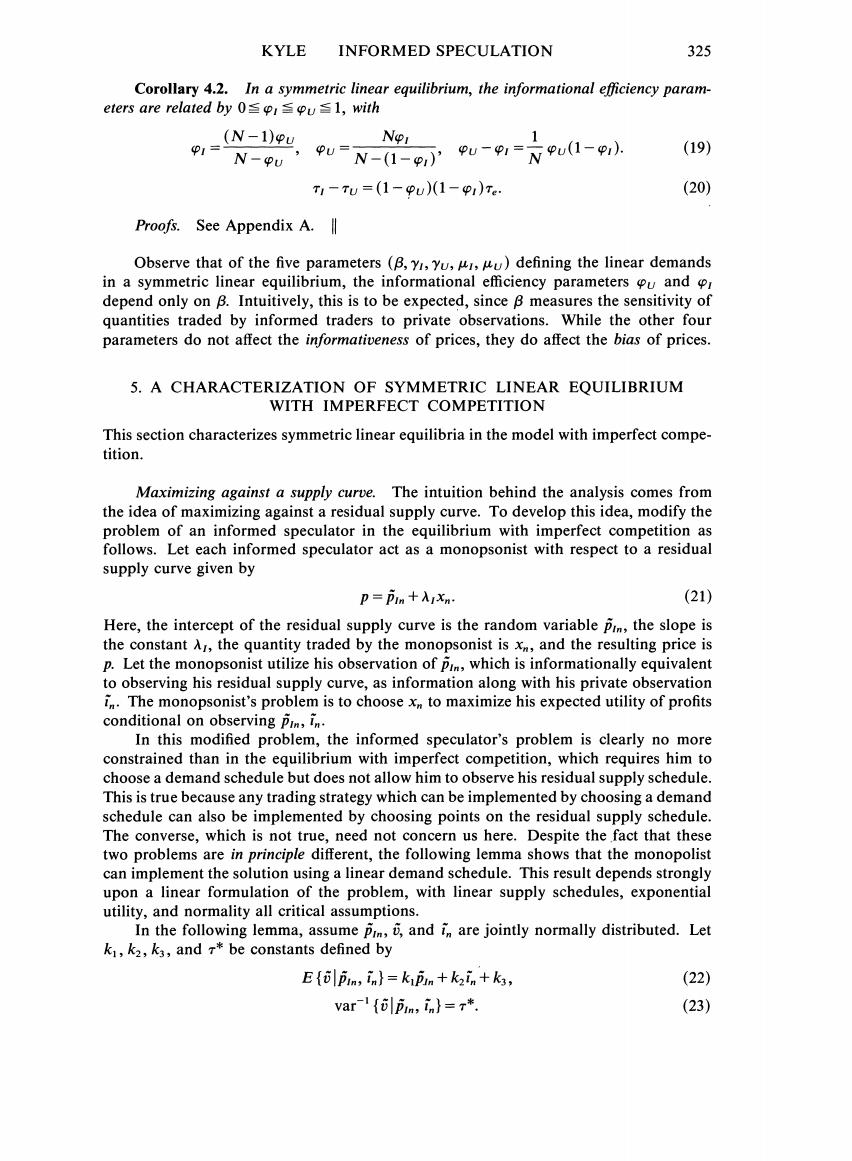正在加载图片...

KYLE INFORMED SPECULATION 325 Corollary 4.2.In a symmetric linear equilibrium,the informational efficiency param- eters are related by 01,with (N-1)Pu Nor P1= N-PU-N-(1)PU-PI-NPU(1-P1). (19) T1-Tu=(1-pu)(1-p1)Te (20) Proofs.See Appendix A. Observe that of the five parameters(B,yi,Yu,ur,u)defining the linear demands in a symmetric linear equilibrium,the informational efficiency parameters u and pr depend only on B.Intuitively,this is to be expected,since B measures the sensitivity of quantities traded by informed traders to private observations.While the other four parameters do not affect the informativeness of prices,they do affect the bias of prices. 5.A CHARACTERIZATION OF SYMMETRIC LINEAR EQUILIBRIUM WITH IMPERFECT COMPETITION This section characterizes symmetric linear equilibria in the model with imperfect compe- tition. Maximizing against a supply curve.The intuition behind the analysis comes from the idea of maximizing against a residual supply curve.To develop this idea,modify the problem of an informed speculator in the equilibrium with imperfect competition as follows.Let each informed speculator act as a monopsonist with respect to a residual supply curve given by p=pPin+Arxn. (21) Here,the intercept of the residual supply curve is the random variable prm,the slope is the constant A,the quantity traded by the monopsonist is x,and the resulting price is p.Let the monopsonist utilize his observation of pim,which is informationally equivalent to observing his residual supply curve,as information along with his private observation i.The monopsonist's problem is to choose x to maximize his expected utility of profits conditional on observing Pim,in. In this modified problem,the informed speculator's problem is clearly no more constrained than in the equilibrium with imperfect competition,which requires him to choose a demand schedule but does not allow him to observe his residual supply schedule. This is true because any trading strategy which can be implemented by choosing a demand schedule can also be implemented by choosing points on the residual supply schedule. The converse,which is not true,need not concern us here.Despite the fact that these two problems are in principle different,the following lemma shows that the monopolist can implement the solution using a linear demand schedule.This result depends strongly upon a linear formulation of the problem,with linear supply schedules,exponential utility,and normality all critical assumptions. In the following lemma,assume pi,and in are jointly normally distributed.Let k1,k2,k3,and T*be constants defined by E pin;in}kipin +k2in+k3, (22) var(pin,in)=T*. (23)